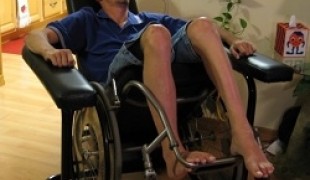- 4729
- 362
- 8
- 5
- 0
- Help Ukraine
About the solution
The wheelchair project, called HU-GO, is currently in its first version, though Riveros has noted that he continues to make modifications and improvements to its design. For instance, in its second iteration, Riveros hopes to be able to 3D print the wheels and/or hubs. In its current version, HU-GO consists of 3D printed parts, a plywood frame, support rods, big wheels (the smaller wheels are 3D printed), and hardware, which include nuts and bolts as well as zip ties.
By looking to his own previously used wheelchair and by analyzing and breaking down its design, Riveros was able to develop a basic design for his own 3D printed wheelchair. It also helped that during the Sydney Olympics in 2000, Riveros worked to assist handicapped people in getting around the Olympic park and received training on how to operate and use a wheelchair. This knowledge has aided him in designing a functional and usable wheelchair.
The most important aspect of Riveros’ HU-GO project is that he has made it with the hopes that it will eventually reach people who are not only disabled physically, but are marginalized within their societies, and even within the world. That is, the design for the 3D printed wheelchair came from a desire to help and provide necessary assistive technology to those who need it, regardless of their wealth or social standing. As he expresses on his Thingiverse page, “I strongly believe that everyone in the world deserves to be able to move about and a wheelchair should not be a luxury item for the few/well off. It should be a tool that anyone should have access to use.”
More info: http://www.hugoriveros.com/
Adapted from: http://bit.ly/1Lkc7fj
What about you, do you have any solutions? Please share them with the Patient Innovation community!
This solution shall not include mention to the use of drugs, chemicals or biologicals (including food); invasive devices; offensive, commercial or inherently dangerous content. This solution was not medically validated. Proceed with caution! If you have any doubts, please consult with a health professional.
DISCLAIMER: This story was written by someone who is not the author of the solution, therefore please be advised that, although it was written with the utmost respect for the innovation and the innovator, there can be some incorrect statements. If you find any errors please contact the patient Innovation team via info@patient-innovation.com
-
-
565
-
0
-
9435

Wheelchair Accessible Recliner
MOVING IN A WHEELCHAIR: Moving using a wheelchair.
CAREGIVING
Cervical spinal cord injury/Tetraplegia
Walking Aid (wheelchair/walker/crutches)
Managing pain
Promoting self-management
Preserving Organ Function
Promoting inclusivity and social integration
Maintaining Balance and Mobility
Restoring Blood Circulation
Preventing (Vaccination, Protection, Falls, Research/Mapping)
Internal Medicine
Neurology
Orthopedics
Rheumatology
United States
-
-
-
511
-
0
-
8693

Patient develops sand rider wheelchair
MOVING IN A WHEELCHAIR: Moving using a wheelchair.
CAREGIVING
Walking Aid (wheelchair/walker/crutches)
Restoring mobility
Promoting self-management
Promoting inclusivity and social integration
To implement a diagnostic tool
Maintaining Balance and Mobility
Caregiving Support
General and Family Medicine
Medical Genetics
Neurology
Orthopedics
Rheumatology
Aging
Mobility issues
Solutions for Disabled people
United States
-
-
-
342
-
0
-
4588

Step articulated and mobile
MOVING IN A WHEELCHAIR: Moving using a wheelchair.
Traveling
Urban exploration
Paralysis
Assistive Daily Life Device (to help ADL)
Walking Aid (wheelchair/walker/crutches)
Restoring mobility
Promoting self-management
Managing Neurological Disorders
Building Supportive Community Relationships
Promoting inclusivity and social integration
Recovering from Traumatic Injuries
Maintaining Balance and Mobility
To improve Treatment/Therapy
Raise awareness
Caregiving Support
Neurology
Orthopedics
Rheumatology
Portugal
-
 en
en